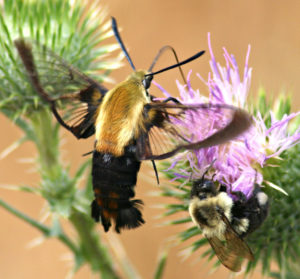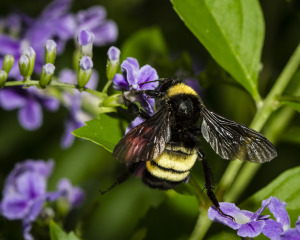Identification
Bumblebees are important pollinators across the United States and Texas lays claim to 9 different species. It’s fairly easy to identify a bumblebee on the fly since they are such large insects, but they can be confused with other insects that you may see buzzing around. Their bodies are very hairy and have black and yellow colorations, though the patterns can be different between species. Bumblebees are often mistaken for carpenter bees (and vice versa), however there is one major characteristic that you can use to distinguish between the two: carpenter bees are primarily hairless on their abdomen, whereas bumblebees have very hairy abdomens. Other insects that can be mistaken as a bumblebee are robberflies and snowberry clearwings, however robberflies won’t be seen feeding on flowers and snowberry clearwings hover in front of the flower it wants to feed from, whereas bumblebees crawl all over the flower.

Snowberry clearwing

Robber fly that looks like a bumblebee
Some steps to identifying different species are covered by the Texas Parks and Wildlife here: https://tpwd.texas.gov/huntwild/wild/wildlife_diversity/nongame/native-pollinators/bumblebee-id.phtml.
Bumblebees are ground-nesters and will occupy previously excavated cavities. They will not excavate their own nest site. Some preferred bumblebee nest sites are rodent burrows, overturned pots, and others of the like.
Biology
Bumblebees are considered social insects, meaning that each colony has a caste system in which each individual bee has a task (or tasks) that they are responsible for. The different castes in a bumblebee colony are: the queen, female workers, and males. The queen is solely responsible for laying eggs, whereas the female workers take on the tasks of foraging, brood care, nest maintenance, and defense. The males have no task other than to mate with reproductive females.
A colony is founded by one mated female (the foundress queen) that overwintered alone. In the early spring she will search for a new nest site, start constructing the nest, and forage for pollen and nectar. Once stores have been collected, the queen will lay eggs that will emerge into female workers. Soon after the female workers emerge, the queen assumes the task of egg-laying and will never leave the nest, while the female workers take on the other tasks needed to maintain the colony. In the mid- to late summer reproductive females and males are reared. If the worker population in the colony is large enough, only then will the colony’s queen lay eggs that will become reproductive females and therefore the following spring’s queens. Only large colonies will produce queens because they have the worker force to gather enough resources to feed the developing queens. Small colonies will only produce males and no queens. Adult male bumblebees leave the nest soon after emergence and never return. They spend their days feeding on nectar and defending territories with the hopes of attracting a new queen. Once a queen has been mated she will spend the rest of the summer and fall feeding and building up fat reserves to survive through the winter. The original colony dies off near the end of the fall.
Bumblebee colonies do not store large quantities of nectar and pollen like honey bees. Instead they are heavily reliant upon the succession of blooms in the surrounding area from spring to fall. If sufficient resources are available, a bumblebee colony can reach a population size of 300-600 workers.
For more information about bumble bees, check out the Texas Parks and Wildlife website.


